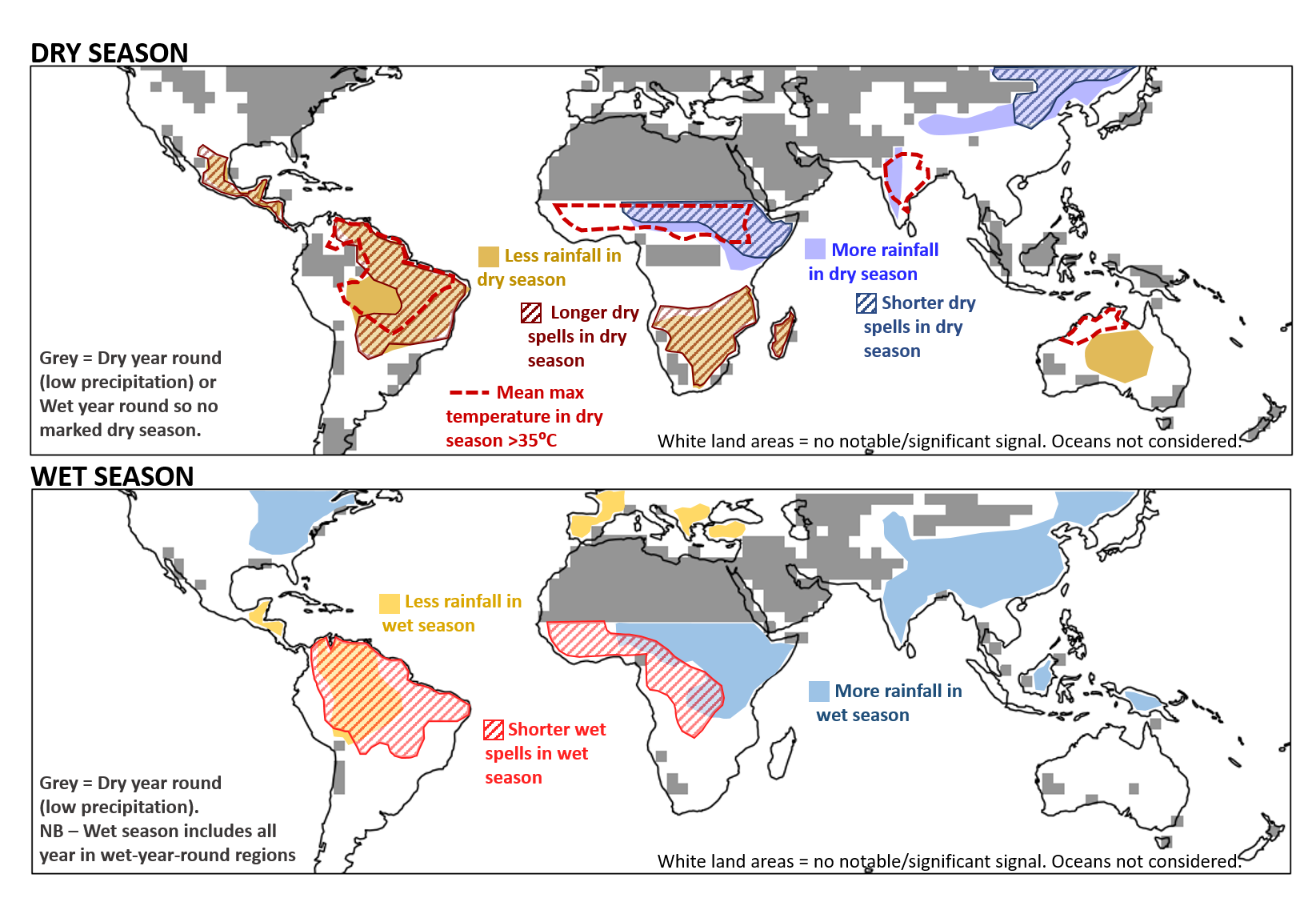The latest Intergovernmental Panel on Climate Change (IPCC) report states that the global water cycle will intensify with continued global warming. This means fewer rainy days, but with more intense rain over many land regions, and more variability generally. More dry days and longer dry spells have the potential to lead to negative impacts on crop yields and food security, as reductions in water availability limit crop growth. The impacts on crops also depend on the timing of these longer dry spells in the annual cycle and future delays in the wet season are also reported in the IPCC report and by my previous research.
Guest post by Caroline Wainwright
Exploiting the latest, state of the art computer simulations, we have examined changes in wet and dry spell characteristics under future climate change across the tropics, applying novel techniques to diagnose wet and dry season changes. The results of our new research are summarised in the schematic below.

We find the start of wet season is projected to be delayed by up to 2 weeks by the end of the 21st century across South America, southern Africa, West Africa, and the Sahel. This is important since it can affect the planting of crops.
We also find a reduction in dry season rainfall and an increase in dry spell length during the dry season across Central and South America, southern Africa, and Australia. Mean dry season dry spell lengths are projected to increase by 5–10 days over northeast South America and southwest Africa. This may make the dry seasons more intense, negatively impacting perennial crops, such as cocoa, and crops grown during the dry season.
However, changes in dry spell length during the wet season are much smaller across the tropics. Therefore, agriculture grown solely during the wet season may be less affected by longer dry spells.
Temperature increases are projected to be larger in dry seasons than in wet seasons, with increases in dry season maximum temperatures found to be up to 3°C higher than the increases in wet season maximum temperatures over South America, southern Africa, and parts of Asia. In these regions, mean maximum temperatures greater than 35°C become more expansive with warming.
Overall, while we find that changes in dry spell length during the wet season are generally small, longer dry spells, fewer wet days, and higher temperatures during the dry season may lead to increasing dry season aridity and have detrimental consequences for perennial crops. As the latest IPCC report states, limiting human-induced global warming and associated changes in the water cycle requires rapid and sustained cuts in CO₂, such that emissions are balanced by additional uptake by the land and ocean, along with strong reductions in other greenhouse gas emissions.
References
Douville, H. et al. (2021) Water Cycle Changes. In: Climate Change 2021: The Physical Science Basis. Contribution of Working Group I to the Sixth Assessment Report of the Intergovernmental Panel on Climate Change, In press [Masson-Delmotte, V., et al.] www.ipcc.ch/report/ar6/wg1/downloads/report/IPCC_AR6_WGI_Chapter_08.pdf
Dunning C.M., Black, E. and Allan, R.P. (2018), Later wet seasons with more intense rainfall over Africa under future climate change, J. Climate, 31, 9719-9738, doi: 10.1175/JCLI-D-18-0102.1.
IPCC, 2021: Summary for Policymakers. In: Climate Change 2021: The Physical Science Basis. Contribution of Working Group I to the Sixth Assessment Report of the Intergovernmental Panel on Climate Change [Masson-Delmotte, V., P. Zhai, A. Pirani, S. L. Connors, C. Péan, S. Berger, N. Caud, Y. Chen, L. Goldfarb, M. I. Gomis, M. Huang, K. Leitzell, E. Lonnoy, J.B.R. Matthews, T. K. Maycock, T. Waterfield, O. Yelekçi, R. Yu and B. Zhou (eds.)]. Cambridge University Press. In Press.
Wainwright, C. M., Black, E., and Allan, R. P. (2021). Future Changes in Wet and Dry Season Characteristics in CMIP5 and CMIP6 Simulations. Journal of Hydrometeorology 22, 9, 2339-2357, doi: 10.1175/JHM-D-21-0017.1